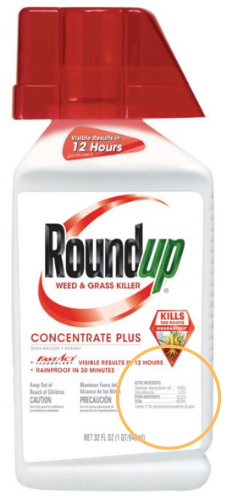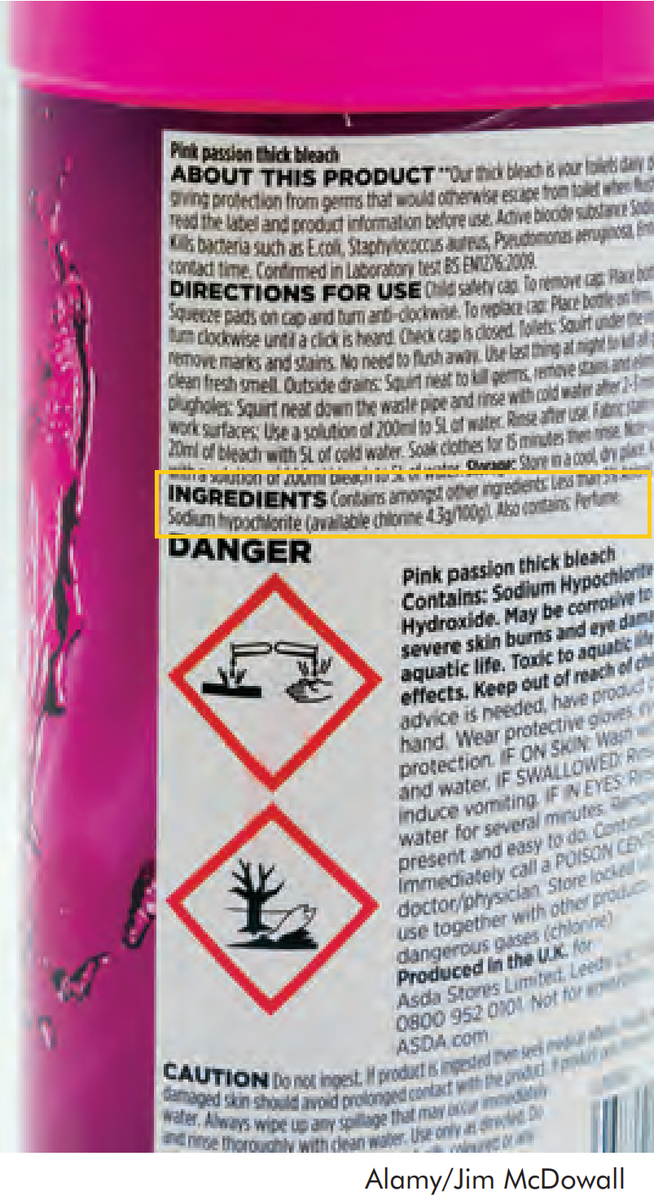Gateway on Pesticide Hazards and Safe Pest Management
How To Find Ingredients in Pesticide Products
Beyond Pesticides offers resources below to evaluate the health and ecological effects of specific chemical exposure from ACTIVE INGREDIENTS in pesticide products, as well as regulatory information and supporting scientific documents. Because various pesticide products can contain more than one active ingredient, it is important to READ the LABEL to determine chemical components.
With 192 different active ingredients and counting, it is essential to establish the connection between the use of these chemicals and their respective hazards.
View the step-by-step guide on how to search for the active ingredient(s) in pesticide products below:
- Go to U.S. EPA's Pesticide Product and Label System and enter the product name. The generic product name may vary.
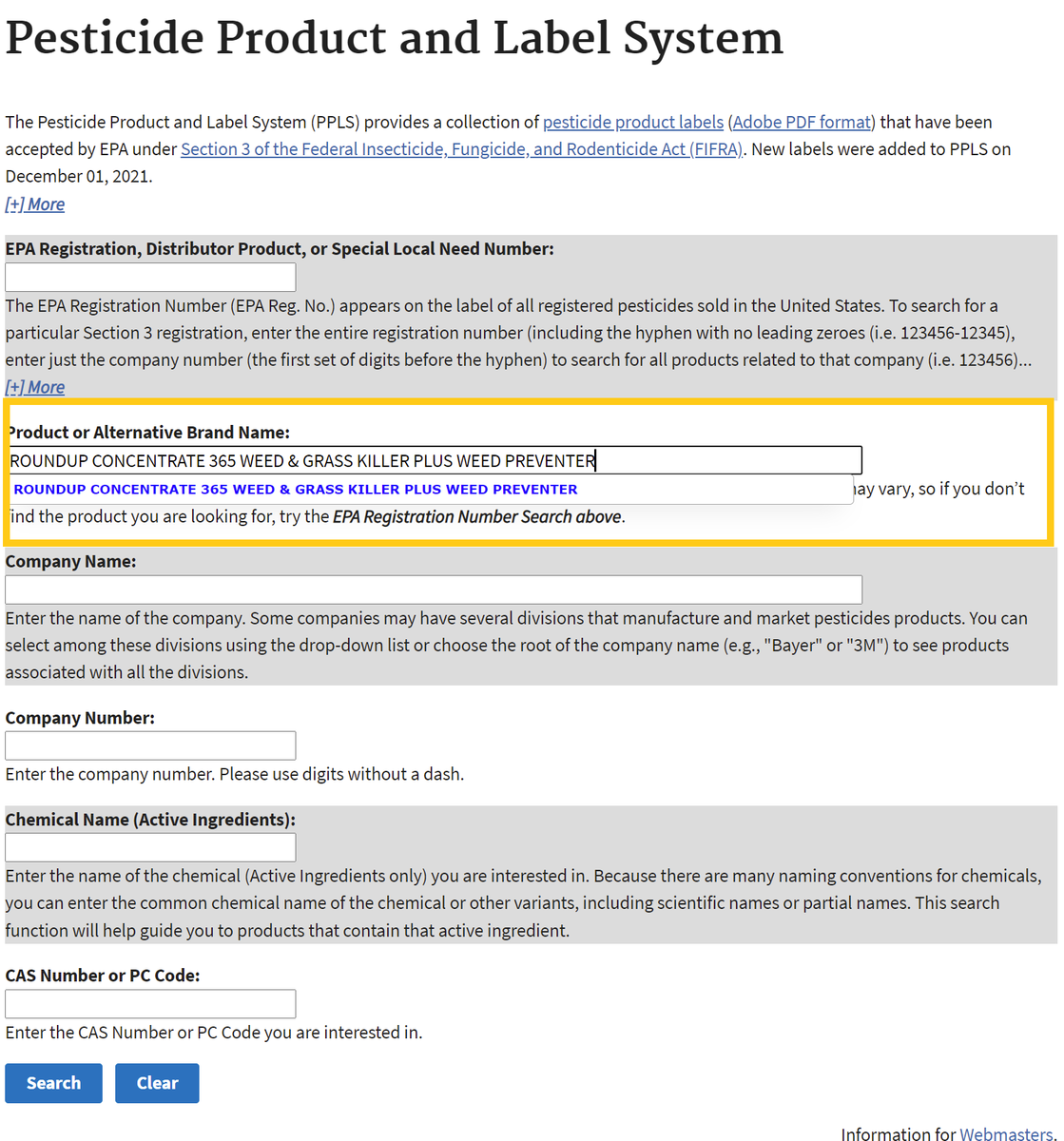
- After searching, click on the chemical ingredients tab or the link for the most recent label to find Active Ingredients.
Chemical List Label List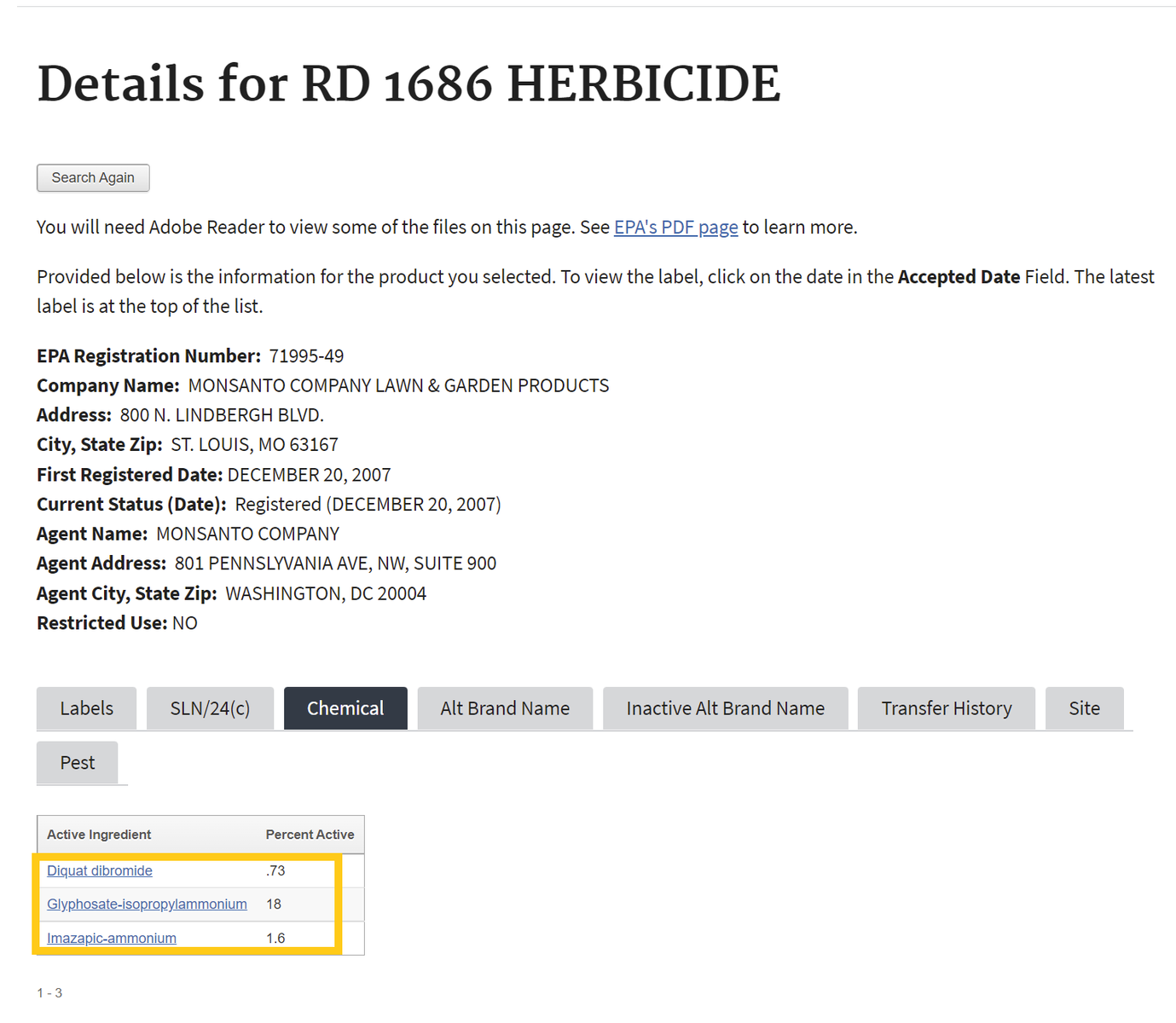
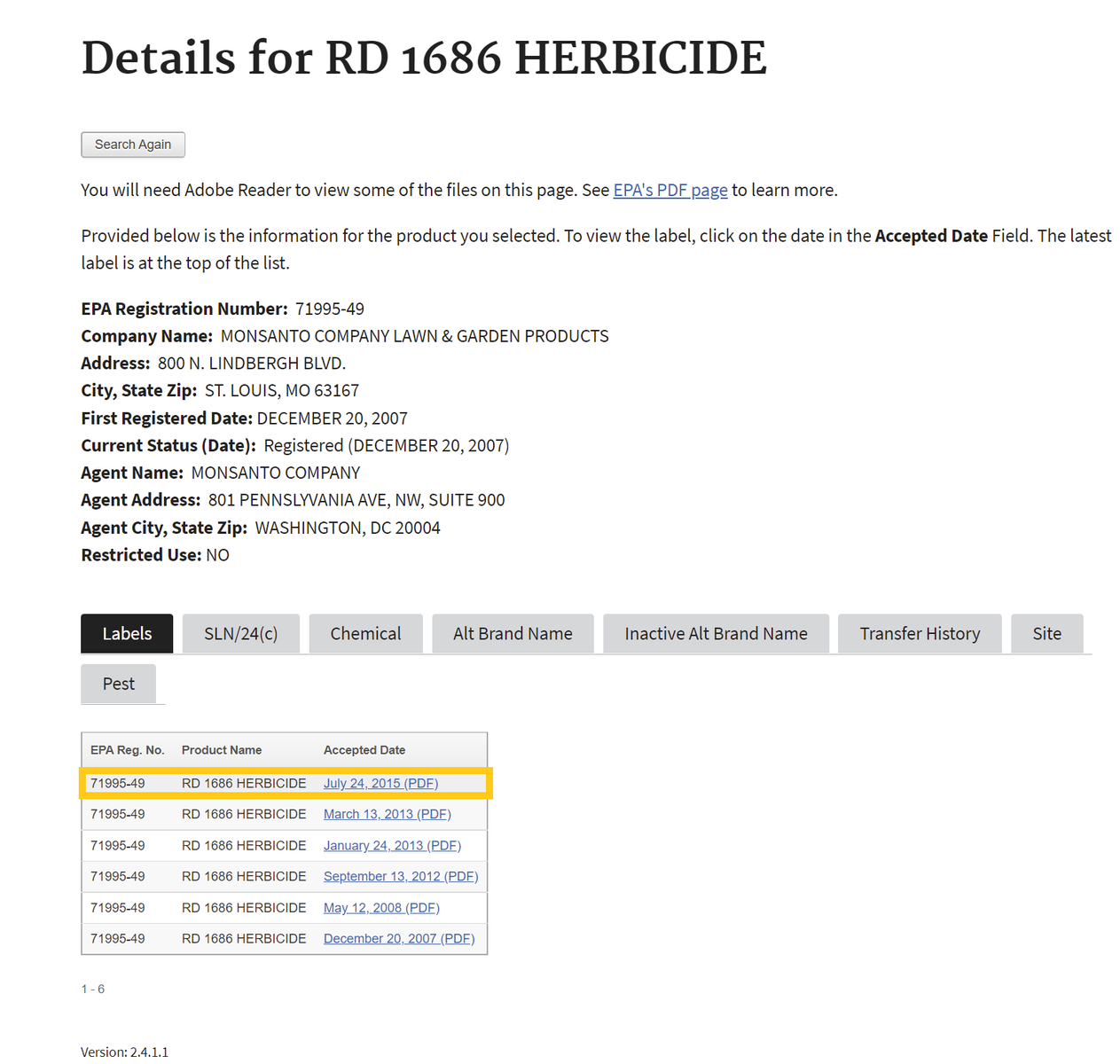
If one selects the chemical ingredients tab, skip to Step 4 . If not, proceed to step number 3 - To find the active ingredient(s) on the label, search for the page in the document containing the date of registration. Usually, the active ingredients section occurs within the first few pages of the label document.
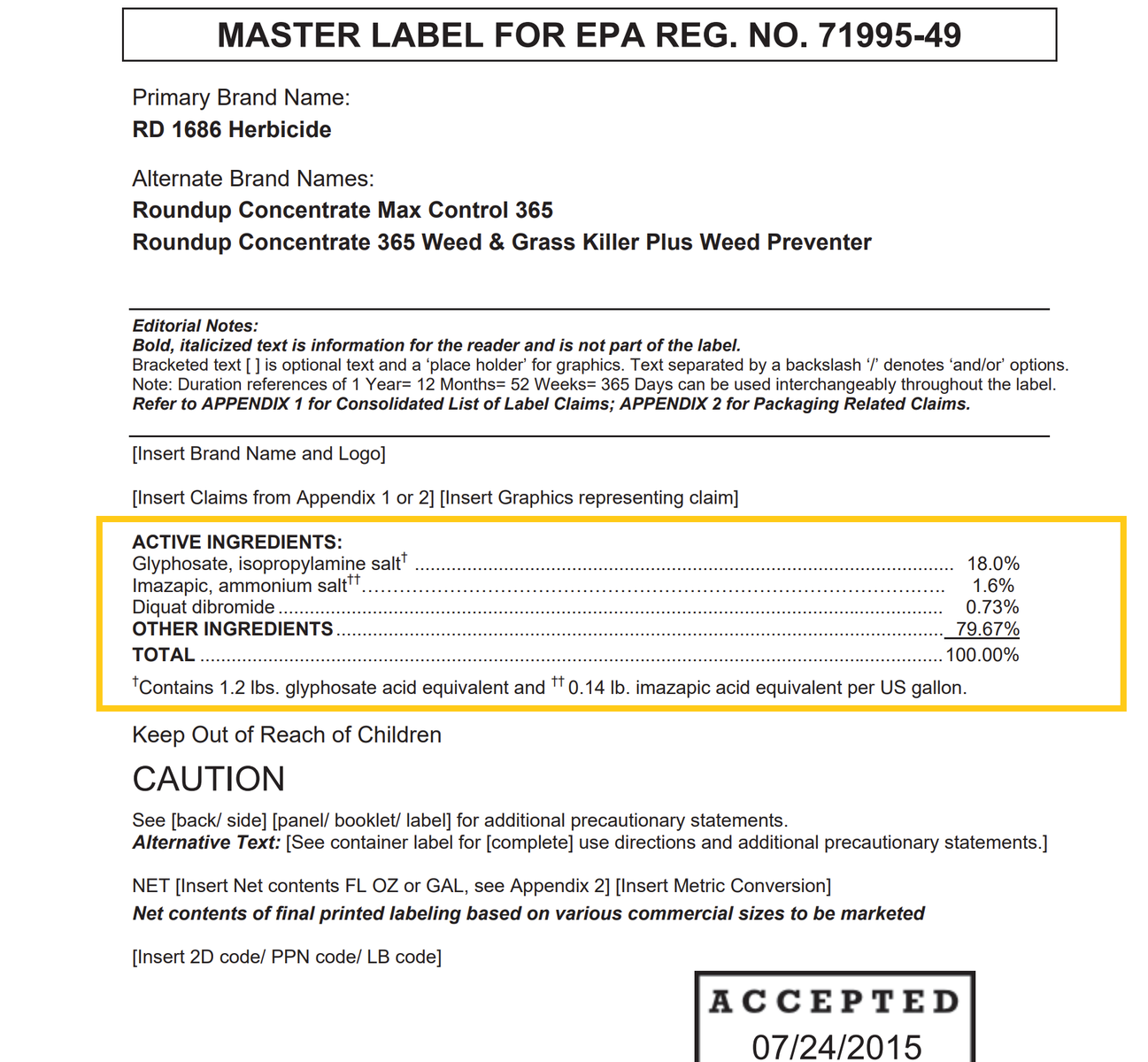
- Return to the Beyond Pesticides Gateway and search for the active ingredient name in the yellow box to the right or from the list below.
Endosulfan
General Information
- Fact Sheet: endosulfan_final.pdf
- Product Names:
- Chemical Class: Organochlorine
- Uses: Contact insecticide in vegetables, fruits, cereal grains, and cotton, as well as ornamental shrubs, trees, vines, and ornamentals for use in commercial agricultural settings.
- Alternatives: Organic agriculture
- Beyond Pesticides rating: Toxic
Health and Environmental Effects
- Cancer: Not documented
- Endocrine Disruption: Yes (30)
- Reproductive Effects: Yes (4)
- Neurotoxicity: Yes (4)
- Kidney/Liver Damage: Yes (32)
- Sensitizer/ Irritant: Yes (4)
- Birth/Developmental: Yes (7)
- Detected in Groundwater: Yes (4)
- Potential Leacher: Not documented
- Toxic to Birds: Yes (8)
- Toxic to Fish/Aquatic Organisms: Yes (8)
- Toxic to Bees: Yes (19)
Residential Uses as Found in the ManageSafe™ Database
Additional Information
- Regulatory Status:
- EPA Reregistration Eligibility Decision (RED) signed (11/2002)
- Lawsuit filed by Pesticide Action Network, Beyond Pesticides, NRDC, UFW et. al (7/2008)
- Scientists' call to ban endosulfan (5/2008)
- EPA Announces Move to Terminate Use of Endosulfan (6/2010)
- Supporting information:
- Daily News Blog entries (Beyond Pesticides)
- Extoxnet Endosulfan Factsheet (Extension Toxicology Network)
- PAN Pesticides Database:Endosulfan (Pesticide Action Network)
- PAN Endosulfan Program Page (Pesticide Action Network)
- Studies:
- Developmental exposure to pesticides zineb and/or endosulfan renders the nigrostriatal dopamine system more susceptible to these environmental chemicals later in life.. Jia, Z., et al. 2007. Neurotoxicology 28(4):727-735
- Developmental exposure to the organochlorine insecticide endosulfan damages the nigrostriatal dopamine system in male offspring.. Wilson WW, Shapiro LP, et al. 2014. Neurotoxicology. 44:279-87
- Developmental neurotoxic effects of two pesticides: Behavior and neuroprotein studies on endosulfan and cypermethrin.. Lee I, Eriksson P, et al. 2015. Toxicology. 335:1-10.
- Effect of Endosulfan on Male Reproductive Development. Saiyed, H et al. 2003. Environ Health Perspect 111:1958-1962
- Effects of a mixture of pesticides on the adult female reproductive system of Sprague-Dawley, Wistar, and Lewis rats. Pascotto VM, Guerra MT, Franci JA, et al. 2015. J Toxicol Environ Health A. 78(9):602-16
- Human exposure and risk assessment to airborne pesticides in a rural French community.. Coscollà C, López A, Yahyaoui A, Colin P, et al. 2017. Sci Total Environ. 584-585:856-868
- Incidence of organochlorine pesticides and the health condition of nestling ospreys (Pandion haliaetus) at Laguna San Ignacio, a pristine area of Baja California Sur, Mexico.. Rivera-Rodríguez LB, Rodríguez-Estrella R. 2011. Ecotoxicology.;20(1):29-38
- .
- A pesticide and iPSC dopaminergic neuron screen identifies and classifies Parkinson-relevant pesticides. Paul, K.C., Krolewski, R.C., Lucumi Moreno, E., Blank, J., Holton, K.M., Ahfeldt, T., Furlong, M., Yu, Y., Cockburn, M., Thompson, L.K. and Kreymerman, A., 2023. Nature Communications, 14(1), p.2803.
- Endosulfan use and the risk of thyroid cancer: an ecological study. Vasan, V., Alsen, M., Vujovic, D., Genden, E., Sinclair, C. and van Gerwen, M., 2023. Journal of Environmental Science and Health, Part B, 58(1), pp.51-57.
- Genotoxicity and Adverse Human Health Outcomes Among People Living Near Highly Polluted Waste Water Drains in Punjab, India. Thakur, J. et al. (2008) Genotoxicity and Adverse Human Health Outcomes Among People Living Near Highly Polluted Waste Water Drains in Punjab, India, Epidemiology. Available at: https://journals.lww.com/epidem/fulltext/2008/11001/genotoxicity_and_adverse_human_health_outcomes.867.aspx.
- Influence of Pesticides Contamination on Microbial Population of Selected Farmlands. Uneze, D.P., Kugbenu, G.J. and Obire, O. (2024) Influence of pesticides contamination on microbial population of selected farmlands, British Journal of Environmental Sciences. Available at: https://eajournals.org/bjes/vol12-issue-5-2024/influence-of-pesticides-contamination-on-microbial-population-of-selected-farmlands/.
- Thyroid under Attack: The Adverse Impact of Plasticizers, Pesticides, and PFASs on Thyroid Function. Rodrigues, V.G. et al. (2024) Thyroid under Attack: The Adverse Impact of Plasticizers, Pesticides, and PFASs on Thyroid Function, Endocrines. Available at: https://www.mdpi.com/2673-396X/5/3/32.
- Perinatal exposure to pesticides alters synaptic plasticity signaling and induces behavioral deficits associated with neurodevelopmental disorders. López-Merino, E., Cuartero, M.I., Esteban, J.A. et al. Perinatal exposure to pesticides alters synaptic plasticity signaling and induces behavioral deficits associated with neurodevelopmental disorders. Cell Biol Toxicol 39, 2089–2111 (2023). https://doi.org/10.1007/s10565-022-09697-2
- Air contamination by legacy and current-use pesticides in Brazilian mountains: An overview of national regulations by monitoring pollutant presence in pristine areas. de Souza Guida, Y. et al. (2018) Air contamination by legacy and current-use pesticides in Brazilian mountains: An overview of national regulations by monitoring pollutant presence in pristine areas, Environmental Pollution. Available at: https://www.sciencedirect.com/science/article/abs/pii/S0269749118314441.
- Predicting the relationship between pesticide genotoxicity and breast cancer risk in South Indian women in in vitro and in vivo experiments . Sasikala, S. et al. (2023) ‘Predicting the relationship between pesticide genotoxicity and breast cancer risk in south Indian women in in vitro and in vivo experiments’, Scientific Reports, 13(1). doi:10.1038/s41598-023-35552-3.
- Pesticide-Induced Inflammation at a Glance. Lopes-Ferreira, M. et al. (2023) ‘Pesticide-induced inflammation at a glance’, Toxics, 11(11), p. 896. doi:10.3390/toxics11110896.
- Pesticide exposure and sleep disorder: A cross-sectional study among Thai farmers. Juntarawijit, C. et al. (2025) Pesticide exposure and sleep disorder: A cross-sectional study among Thai farmers, Heliyon. Available at: https://www.cell.com/heliyon/fulltext/S2405-8440(24)17154-X.
- A cocktail of contaminants: how mixtures of pesticides at low concentrations affect aquatic communities. Relyea R. A. (2009). A cocktail of contaminants: how mixtures of pesticides at low concentrations affect aquatic communities. Oecologia, 159(2), 363–376. https://doi.org/10.1007/s00442-008-1213-9
- Chlorpyrifos and endosulfan affect buffalo oocyte maturation, fertilization, and embryo development in vitro directly and through cumulus cells. Nandi, S., Gupta, P.S.P., Roy, S.C., Selvaraju, S. and Ravindra, J.P. (2011), Chlorpyrifos and endosulfan affect buffalo oocyte maturation, fertilization, and embryo development in vitro directly and through cumulus cells. Environ. Toxicol., 26: 57-67. https://doi.org/10.1002/tox.20529
- Pesticide residue in cucumber-exposed plants, and its associated effects on soil nematode population. Imonikebe, P. et al. (2025) Pesticide residue in cucumber-exposed plants, and its associated effects on soil nematode population, Advances in Modern Agriculture. Available at: https://www.researchgate.net/publication/390847748_Pesticide_residue_in_cucumber-exposed_plants_and_its_associated_effects_on_soil_nematode_population.
- Mapping pesticide-induced metabolic alterations in human gut bacteria. Chen, L. et al. (2025) Mapping pesticide-induced metabolic alterations in human gut bacteria, Nature Communications. Available at: https://www.nature.com/articles/s41467-025-59747-6.
- Current‐use pesticides in seawater and their bioaccumulation in polar bear–ringed seal food chains of the Canadian Arctic. Adam D. Morris, Derek C.G. Muir, Keith R. Solomon, Robert J. Letcher, Melissa A. McKinney, Aaron T. Fisk, Bailey C. McMeans, Gregg T. Tomy, Camilla Teixeira, Xiaowa Wang, Mark Duric, Current‐use pesticides in seawater and their bioaccumulation in polar bear–ringed seal food chains of the Canadian Arctic, Environmental Toxicology and Chemistry, Volume 35, Issue 7, 1 July 2016, Pages 1695–1707, https://doi.org/10.1002/etc.3427
- Current‐use pesticide transport to Costa Rica's high‐altitude tropical cloud forest. Chubashini Shunthirasingham, Todd Gouin, Ying D Lei, Clemens Ruepert, Luisa E Castillo, Frank Wania, Current‐use pesticide transport to Costa Rica's high‐altitude tropical cloud forest, Environmental Toxicology and Chemistry, Volume 30, Issue 12, 1 December 2011, Pages 2709–2717, https://doi.org/10.1002/etc.671
- Atmospheric Deposition of Current-Use and Historic-Use Pesticides in Snow at National Parks in the Western United States. Hageman, K. J., Simonich, S. L., Campbell, D. H., Wilson, G. R., & Landers, D. H. (2006). Atmospheric deposition of current-use and historic-use pesticides in snow at national parks in the western United States. Environmental science & technology, 40(10), 3174–3180. https://doi.org/10.1021/es060157c
- Species at Risk (SPEAR) index indicates effects of insecticides on stream invertebrate communities in soy production regions of the Argentine Pampas. Hunt, L., Bonetto, C., Marrochi, N., Scalise, A., Fanelli, S., Liess, M., Lydy, M. J., Chiu, M. C., & Resh, V. H. (2017). Species at Risk (SPEAR) index indicates effects of insecticides on stream invertebrate communities in soy production regions of the Argentine Pampas. The Science of the total environment, 580, 699–709. https://doi.org/10.1016/j.scitotenv.2016.12.016
- Status of pesticides pollution in Tanzania – A review. Elibariki, R., & Maguta, M. M. (2017). Status of pesticides pollution in Tanzania - A review. Chemosphere, 178, 154–164. https://doi.org/10.1016/j.chemosphere.2017.03.036
- Residues of pesticides and metabolites in chicken kidney, liver and muscle samples from poultry farms in Dar es Salaam and Pwani, Tanzania. Mahugija, J. A. M., Chibura, P. E., & Lugwisha, E. H. J. (2018). Residues of pesticides and metabolites in chicken kidney, liver and muscle samples from poultry farms in Dar es Salaam and Pwani, Tanzania. Chemosphere, 193, 869–874. https://doi.org/10.1016/j.chemosphere.2017.11.094
- Tracking toxic chemical exposure in Uganda: Insights from silicone wristbands. Essandoh, Yaw Edu et al. “Tracking toxic chemical exposure in Uganda: Insights from silicone wristbands.” Environmental research vol. 277 (2025): 121522. doi:10.1016/j.envres.2025.121522
- Global patterns of pesticide residues in seaweeds: A systematic review. Azevedo, G. et al. (2025) Global patterns of pesticide residues in seaweeds: A systematic review, Marine Pollution Bulletin. Available at: https://www.sciencedirect.com/science/article/pii/S0025326X25011841.








.png)
